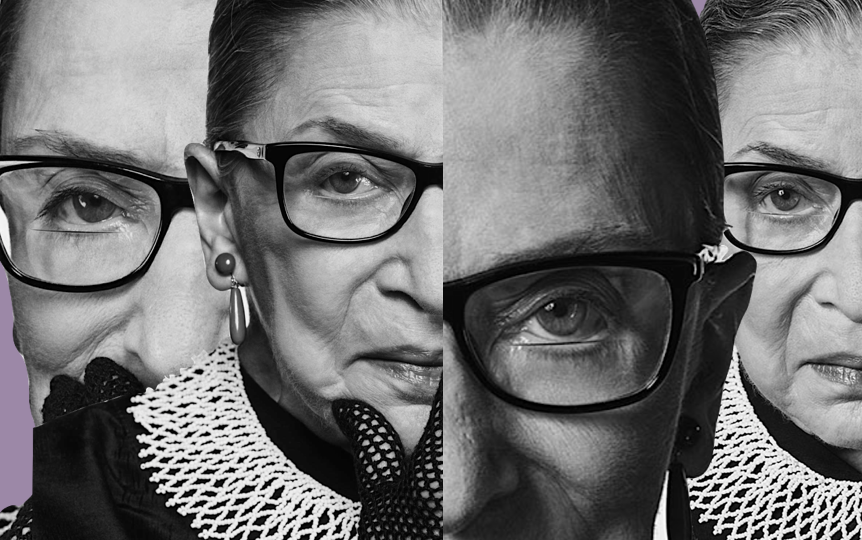Ruth Bader Ginsburg fell two weeks ago. Not in a metaphorical manner, but in a strictly physical one: the justice tripped and fractured three ribs on Wednesday 7th, being admitted to the hospital the following morning.
Ms. Ginsburg has frequently -and rightfully- been deemed an icon. Since graduating first of her class from Columbia Law School, Ginsburg has proven an extraordinary jurist and resilient liberal voice. From co-founding ACLU’s Women’s Rights Project to becoming the first supreme court justice to officiate a same-sex wedding, the first Jewish woman of the court has been a restless trailblazer. My own generation (which commentators have settled on dubbing “Gen-Z” in order to prevent the further expansion of the term millennial) has embraced her, through both a biopic- the latest indicator of public relevance- and a dedicated store, The Notorious RBG, which sells t-shirt emblazoned with her face and captions such as “SUPREME QUEEN”, ”YOU CAN’T SPELL TRUTH WITHOUT RUTH” and “THE RUTH WILL SET YOU FREE”.
And yet, upon hearing about her fall, I realized my first thoughts did not concern the health of the ‘Supreme Queen’ at all. Unlike my reaction to the struggles (and eventual deaths) of Liu Xiaobo, Harper Lee or Carrie Fisher, my primary preoccupation was not the continued existence of an admirable, unique individual. Instead of being upset at the possibility of an extraordinary jurist passing away, I was mourning the practicalities of such an event. Couldn’t she have fallen before 2016, or at least after 2020? Didn’t she realize that Republicans had just solidified their Senate majority, allowing for a young arch-conservative to replace her? An 85-year-old woman whom I admired deeply was experiencing a serious health debacle and all I could think about was the poor timing of the whole ordeal.
Worst of all, my cold political calculation was not the exception, but the rule. The UK’s BBC ran the headline ‘Ruth Bader Ginsburg: Why half of America panics when this woman falls ill’, and a million liberal hearts skipped a beat upon receiving the dire NYT notification. Ginsburg’s position had nullified her very identity, transforming a complex and fascinating woman into a piece in an arithmetic puzzle for control of a chamber. Sure, a couple playful tweets, such as Teen Vogue columnist Lauren Duca’s “I hereby donate all of my ribs and organs to Ruth Bader Ginsburg”, lightened the mood. But the core message remained: RBG’s death would be extremely untimely for the American left.
It is worth taking a minute to analyze the terrible nature of a system that perpetuates these dynamics. After all, my concern for Ginsburg’s health is most likely the prettier face of the coin- certainly more palatable than the likely reaction of a solidly red voter or a liberal’s response to Scalia’s death. The current process for appointing supreme court justices, a lottery which has given popular-vote-loser President Trump as many nominations in two years as Barack Obama had in eight, could be seen as the chief culprit. Indeed, the appointment system endows the court with a degree of mesmerizing unpredictability where pivotal rulings essentially depend on the cholesterol levels or pulmonary health of the serving judges. President Nixon’s appointing of 4 SCOTUS justices over his first term, compared to Carter’s lack of nominations over an equivalent period, exhibits the degree to which gambling on the death and decay of the court’s members produces unbalanced results. Justices themselves are aware of such issues, and frequently have to mould the last years of their lives according to a political climate they cannot control, delaying or accelerating retirement plans to ensure the appointment of an ideological peer (Ginsburg herself, in further evidence of the strength of her character, refused to do so during the Obama years, pointing to how her work helped her recover after her husband’s death). Not only does this nomination system challenge the legitimacy of the court, but it leads to fiercely partisan battles over the appointments themselves, as seen in the Merrick Garland and Kavanaugh debacles, as politicians scramble to secure one of the coveted and rarely accessible seats. Precisely because of this need to seize every available opportunity, both parties are unlikely to compromise whenever they have the presidency (and hence the upper hand), which makes legislative solutions, such as a fixed number of appointments per president, unlikely.
If the court was not a political institution, as many insist it should be, this would not present a significant issue: a Ginsburg replacement would affect the court remarkably little, as decisions would be based purely on neutral interpretations of the constitution. Yet, as the post-Warren rise of the Federalist Society (a conservative association which ensures the right-wing pedigree of supreme court nominees for Republican presidents) and the crucial ruling in the 2000 Florida recount show, the supreme court is anything but un-partisan. America’s Common Law legal system (where judicial precedent molds the law, in contrast to Europe’s predominant Civil Law legal systems) and the presence of judicial activism within the institution (arguably best exemplified by the Roe v Wade ruling) only exacerbate these dynamics, bestowing enormous power upon an institution whose tilt relies on whether an 85-year-old trips over her office’s carpet.
Justice Ginsburg appears to be on track to recovery, having returned to her home. If her physical health is as solid as her tenacity and workout videos suggest, she will grace America with her unique wit and powerful voice for years to come. But the court she dutifully serves remains broken, with no clear solution in sight.




